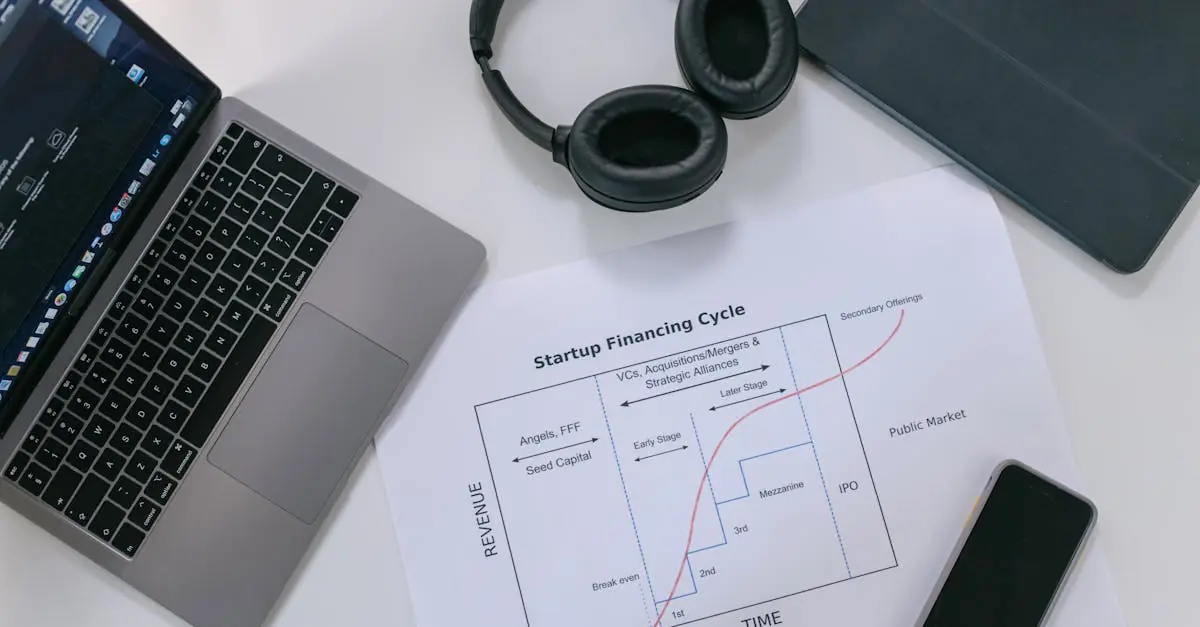In a world where coding often feels like deciphering an ancient language, no-code bootcamps are the shiny lifeboats rescuing aspiring creators from the tech-turbulence. These bootcamps offer a delightful escape, allowing anyone—from budding entrepreneurs to seasoned professionals—to build apps and websites without wrestling with complex code. Imagine crafting your digital masterpiece while sipping coffee instead of battling syntax errors. Sounds dreamy, right?
Table of Contents
ToggleOverview of No-Code Bootcamps
No-code bootcamps offer an innovative approach for individuals seeking to develop digital products without traditional programming. These programs cater to diverse groups, including entrepreneurs, marketers, and small business owners. Participants learn to utilize visual development tools that simplify the app and website creation processes.
Courses typically cover essential topics such as design principles, user experience, and project management. Many bootcamps focus on popular no-code platforms like Bubble, Webflow, and Adalo. Each platform provides unique functionalities, allowing students to gain hands-on experience tailored to their specific goals.
The duration of these bootcamps varies, ranging from a few weeks to several months. Flexible scheduling options, including part-time and full-time tracks, accommodate different learning paces and lifestyles. Many no-code bootcamps also feature community support, enabling students to connect with peers and industry experts.
Additionally, mentorship plays a crucial role in these programs. Instructors often provide personalized feedback and guidance, fostering a collaborative learning environment. By the end of the training, graduates usually possess a portfolio showcasing their completed projects.
As no-code tools continue to evolve, bootcamps adapt their curricula to incorporate the latest trends and technologies. Understanding this landscape empowers participants to stay competitive in the job market. No-code bootcamps represent an accessible pathway for those who aspire to bring their digital ideas to life efficiently.
Benefits of No-Code Bootcamps
No-code bootcamps provide numerous advantages for individuals aiming to build digital solutions without prior coding experience.
Accessibility for Non-Technical Individuals
No-code bootcamps enable non-technical individuals to explore their creativity without the barriers of coding languages. Individuals from various backgrounds, such as business and marketing, can easily learn to create websites and apps. Programs often utilize intuitive tools that require minimal technical knowledge, making it feasible for anyone to start building digital projects. Training focuses on visual interfaces, allowing users to design and implement features with simple drag-and-drop actions. By demystifying the development process, these bootcamps empower participants to take ownership of their ideas and transform them into tangible products.
Rapid Prototyping and Development
No-code bootcamps facilitate rapid prototyping and development, enabling quick iterations of digital concepts. Participants can swiftly develop and test their ideas, significantly reducing time-to-market for new products. The courses emphasize practical applications, allowing students to build functional prototypes on no-code platforms within weeks. Immediate feedback from peers and mentors accelerates improvement, helping refine projects efficiently. This approach not only fosters creativity but also eliminates the lengthy traditional development cycles, positioning graduates to remain competitive in a fast-paced digital landscape.
Popular No-Code Bootcamps
No-code bootcamps attract a diverse range of participants aiming to create digital products without traditional coding skills. Various programs emphasize different aspects of no-code development, enhancing the learning experience.
Comparison of Curriculum
Curriculums often differ across bootcamps, focusing on various platforms and skills. Some bootcamps emphasize Bubble for app development, while others may highlight Webflow for web design. Essentials like design principles and user experience are universal topics, but the depth of exploration varies. Participants in one bootcamp might engage in hands-on projects, whereas another might prioritize theory and concepts. Courses also accommodate different schedules, with some offering part-time commitments or self-paced options.
Success Stories from Graduates
Graduates frequently share inspiring success stories that highlight the effectiveness of no-code bootcamps. Many have launched startups that gained significant traction after completing their programs. Some participants transitioned from traditional roles in fields like marketing to tech-savvy positions, utilizing the skills acquired during bootcamp training. A few individuals created successful apps that solved real-world problems, demonstrating the potential of no-code tools. Each graduate experience underscores the transformative impact of these bootcamps on personal and professional trajectories.
Challenges of No-Code Bootcamps
No-code bootcamps face several challenges that can impact their effectiveness and the experience of their participants.
Limitations of No-Code Tools
No-code tools, while user-friendly, have inherent limitations that can restrict creativity. Lack of flexibility in customization often frustrates users seeking unique solutions. Participants may encounter performance issues, especially with complex applications. Moreover, scalability problems arise as applications grow, potentially hindering business expansion. Many no-code platforms also impose restrictions on integrations with existing systems, which can limit functionality. Users may find themselves constrained by the pre-built templates and features offered, leading to dissatisfaction among those with advanced needs.
Market Perception and Value
Market perception of no-code bootcamps varies across industries. Some view these programs as valuable pathways for innovation and entrepreneurship, while others question their technical rigor. Graduates frequently report increased job opportunities, which enhances the appeal of no-code education. Potential employers might undervalue no-code skills, citing a preference for traditional coding knowledge. A strong perception of no-code as a legitimate skill set is crucial for the long-term success of these bootcamps. Building awareness about the potential of no-code tools can further elevate their market position and attract broader interest.
No-code bootcamps are transforming the landscape of digital creation. They empower individuals from various backgrounds to bring their ideas to life without the need for extensive coding knowledge. With a focus on practical skills and community support, these programs foster an environment where creativity can flourish.
As the demand for digital solutions continues to grow, no-code bootcamps provide a valuable alternative for aspiring entrepreneurs and professionals. While challenges exist, the benefits of accessibility and rapid development make these bootcamps an attractive option. Graduates are well-equipped to navigate the evolving job market and leverage their newfound skills to drive innovation. Embracing no-code tools can unlock immense potential for those ready to step into the digital realm.

